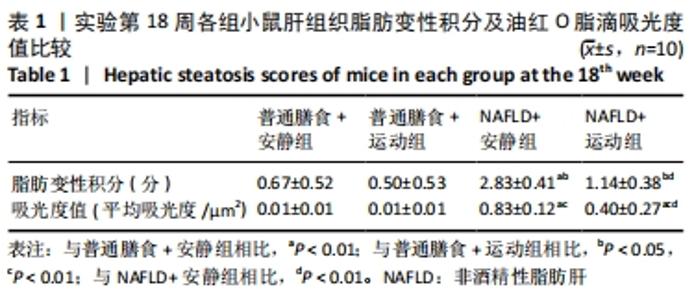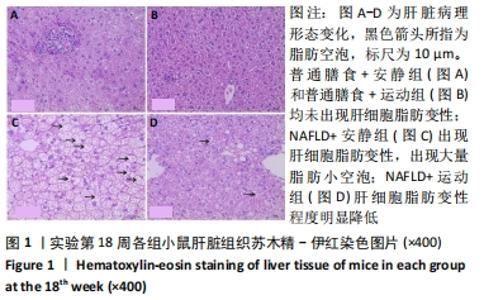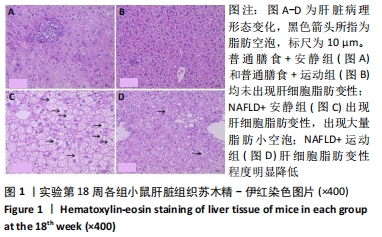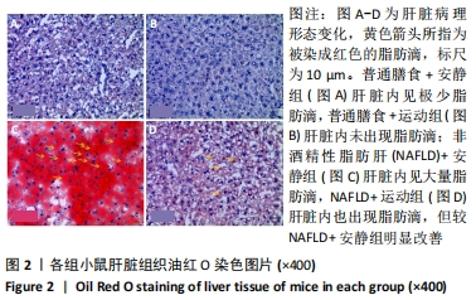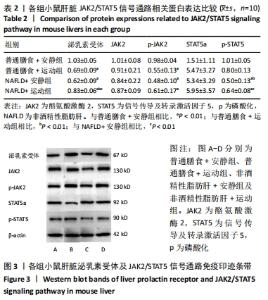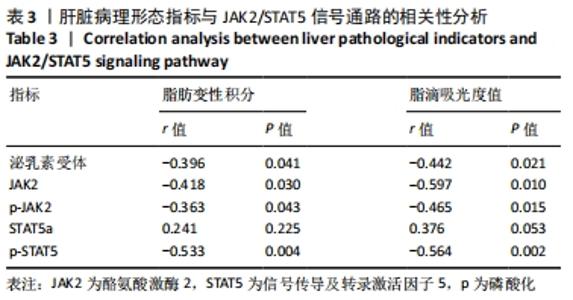[1] FAN JG, KIM SU, WONG VW. New trends on obesity and NAFLD in Asia. J Hepatol. 2017;67(4):862-873.
[2] 范建高.中国非酒精性脂肪性肝病诊疗指南(2010年修订版)[J]. 中国医学前沿杂志(电子版),2012,4(7):4-10.
[3] LI W, ALAZAWI W. Non-alcoholic fatty liver disease. Clin Med. 2020; 20(5):509-512.
[4] 瞿玉兰,韩泽广.脂代谢紊乱在非酒精性脂肪肝发病中的作用[J].中国科学:生命科学,2017,47(5):496-507.
[5] MARCHESINI G, BRIZI M, BIANCHI G, et al. Nonalcoholic fatty liver disease: a feature of the metabolic syndrome. Diabetes. 2001;50(8): 1844-1850.
[6] SAMUEL VT, SHULMAN GI. Nonalcoholic Fatty Liver Disease as a Nexus of Metabolic and Hepatic Diseases. Cell Metab. 2018; 27(1):22-41.
[7] 傅建. 运动对非酒精性脂肪肝干预效果及机制研究[D]. 扬州:扬州大学,2019.
[8] BARCLAY JL, NELSON CN, ISHIKAWA M, et al. GH-dependent STAT5 signaling plays an important role in hepatic lipid metabolism . Endocrinology. 2011;152(1):181-192.
[9] ZHANG Y, ZHOU L, ZHANG Z, et al. Effects of di (2-ethylhexyl) phthalate and high-fat diet on lipid metabolism in rats by JAK2/STAT5. Environ Sci Pollut Res Int. 2020;27(4):3837-3848.
[10] LI J, YANG M, YU Z, et al. Kidney-secreted erythropoietin lowers lipidemia via activating JAK2-STAT5 signaling in adipose tissue. EBioMedicine. 2019;50:317-328.
[11] 张芃子.泌乳素及其受体对非酒精性脂肪肝及肝脏脂代谢的影响及机制研究[D].南京:南京大学,2018.
[12] 陈伊琳. 运动与黑果枸杞活性成分对NAFLD小鼠的干预作用研究[D].长沙:湖南师范大学,2019.
[13] 范建高. 中国非酒精性脂肪性肝病诊疗指南(2010年修订版)[J]. 中国医学前沿杂志(电子版),2012,4(7):4-10.
[14] DUMAS ME, KINROSS J, NICHOLSON JK. Metabolic phenotyping and systems biology approaches to understanding metabolic syndrome and fatty liver disease. Gastroenterology. 2014;146(1):46-62.
[15] 潘磊,张金彪,崔荣岗,等.非酒精性脂肪肝C57BL/6小鼠模型的建立[J].中国组织工程研究,2016,20(40):6054-6059.
[16] 阮凌.不同强度运动对老年脂肪肝大鼠脂代谢异常及氧化应激的影响[J].中国老年学杂志,2019,39(14):3489-3493.
[17] 李军汉,苏全生,孙君志,等.运动和饮食调整对内质网应激介导非酒精性脂肪肝大鼠模型肝细胞凋亡的影响[J].中国运动医学杂志,2017,36(1):36-43.
[18] 李军汉,孙君志,李恩,等. 运动和饮食调整对非酒精性脂肪肝大鼠内质网应激PERK/eIF-2a和IRE-1/XBP-1通路的影响[J]. 成都体育学院学 报,2016,42(6):110-113+126.
[19] 朱达,孙凤霞,李晓玲,等.健脾疏肝丸对非酒精性脂肪性肝病大鼠肝X受体α-固醇调节元件结合蛋白-1-脂肪酸合成酶信号转导通路的影响[J].中国肝脏病杂志(电子版),2020,12(2):60-67.
[20] GOLABI P, LOCKLEAR CT, AUSTIN P. Effectiveness of exercise in hepatic fat mobilization in non-alcoholic fatty liver disease: Systematic review. World J Gastroenterol. 2016;22(27):6318-6327.
[21] KEATING SE, HACKETT DA, PARKER HM, et al. Effect of aerobic exercise training dose on liver fat and visceral adiposity. J Hepatol. 2015;63(1): 174-182.
[22] 郭怡琼,吴琼,吴雅婷,等.枸杞多糖和有氧运动对大鼠非酒精性脂肪肝的干预效果及其机制研究[J].上海交通大学学报(医学版), 2020,40(1):30-36.
[23] BROUWERS B, SCHRAUWEN-HINDERLING VB, JELENIK T, et al. Exercise training reduces intrahepatic lipid content in people with and people without nonalcoholic fatty liver. Am J Physiol Endocrinol Metab. 2018; 314(2):165-173.
[24] 雷鸣,苏映军,王钠,等.泌乳素及其受体的研究进展[J].现代生物医学进展,2016,16(10):1979-1983.
[25] BOLE-FEYSOT C, GOFFIN V, EDERY M, et al. Prolactin (PRL) and its receptor: actions, signal transduction pathways and phenotypes observed in PRL receptor knockout mice. Endocr Rev. 1998;19(3):225-268.
[26] 梅学华,曾雄.催乳素作用机制的研究进展[J]. 畜禽业,2008,29(4): 16-19.
[27] BERNARD V, YOUNG J, CHANSON P, et al. New insights in prolactin: pathological implications. Nat Rev Endocrinol. 2015;11(5):265-275.
[28] SHI SY, LUK CT, BRUNT JJ, et al. Adipocyte-specific deficiency of Janus kinase (JAK) 2 in mice impairs lipolysis and increases body weight, and leads to insulin resistance with ageing. Diabetologia. 2014;57(5):1016-1026.
[29] RICHARD AJ, STEPHENS JM. The role of JAK-STAT signaling in adipose tissue function . Biochim Biophys Acta. 2014;1842(3):431-439.
[30] WU K, TAN XY, XU YH, et al. JAK family members: Molecular cloning, expression profiles and their roles in leptin influencing lipid metabolism in Synechogobius hasta . Comp Biochem Physiol B Biochem Mol Biol. 2017;203:122-131.
[31] KALTENECKER D, THEMANNS M, MUELLER KM, et al. Hepatic growth hormone - JAK2 - STAT5 signalling: Metabolic function, non-alcoholic fatty liver disease and hepatocellular carcinoma progression. Cytokine. 2019;124:154569.
|
